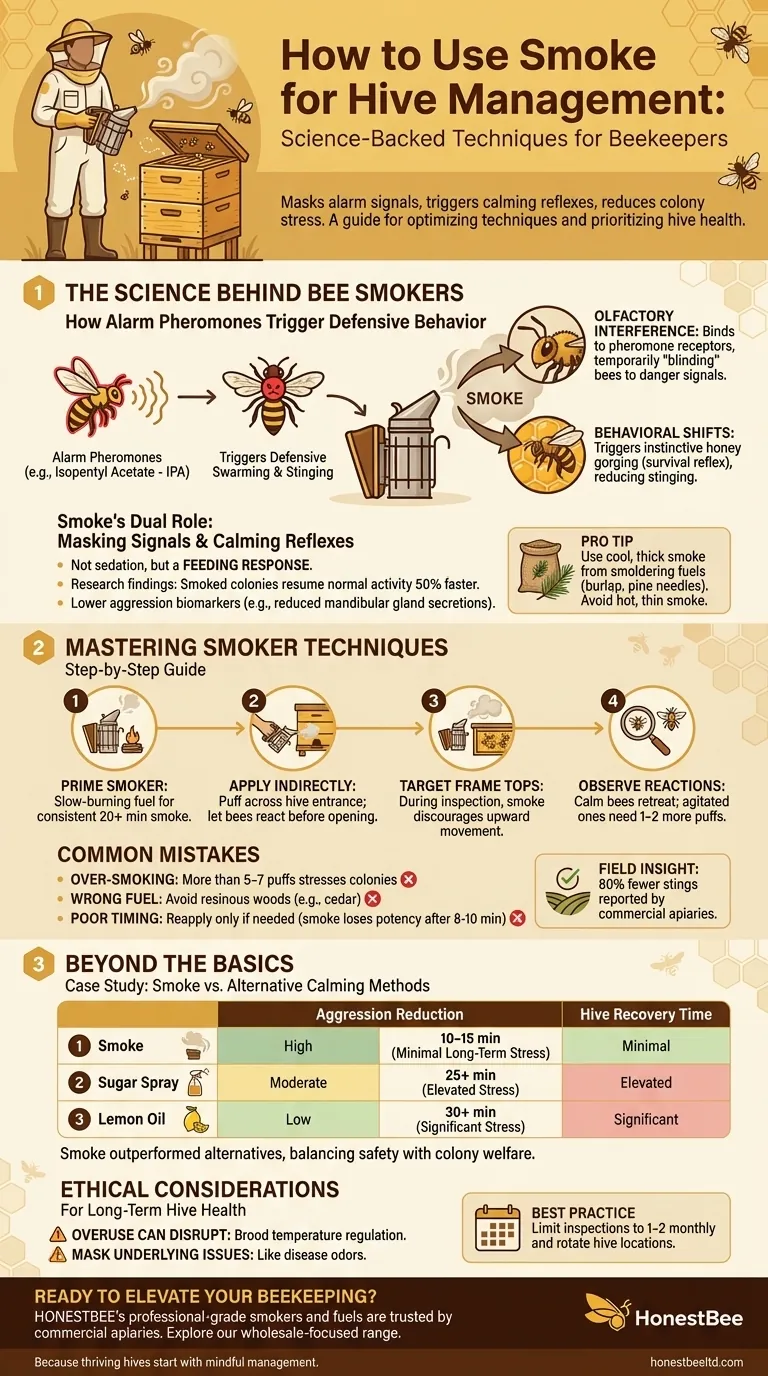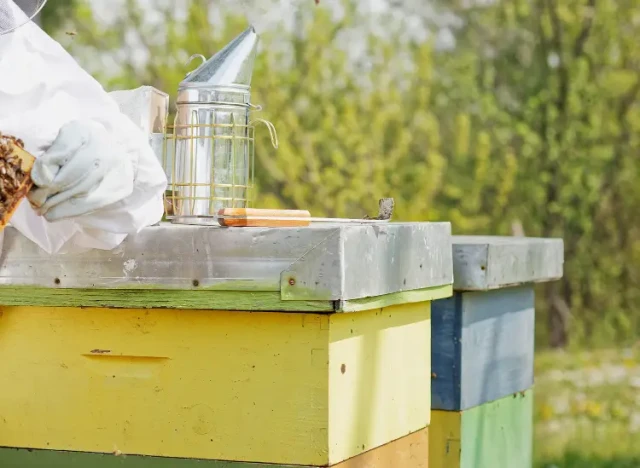수세기 동안 양봉가들은 벌통을 안전하게 검사하고 관리하기 위해 연기에 의존해 왔습니다. 하지만 현대 연구에 따르면 이 관행은 전통 이상입니다. 올바르게 사용하면 연기는 경보 신호를 가리고, 진정 반사를 유발하며, 군집의 스트레스를 줄입니다. 이 가이드는 곤충학적 통찰력과 현장에서 검증된 방법을 결합하여 벌통 건강을 최우선으로 하면서 연기기 사용법을 최적화하는 데 도움을 줄 것입니다.
벌 연기기의 과학
경보 페로몬이 방어 행동을 유발하는 방법
벌은 아이소펜틸 아세테이트(IPA)와 같은 화학 신호를 통해 위협을 전달하며, 이는 공격적인 군집 행동을 유발하는 경보 페로몬입니다. 연구에 따르면 군집은 몇 초 안에 IPA를 감지하여 침입자를 공격하는 경비벌을 동원합니다.
연기는 다음과 같은 방법으로 이 과정을 방해합니다:
- 후각 간섭: 연기 입자가 페로몬 수용체에 결합하여 일시적으로 벌이 위험 신호를 감지하지 못하게 합니다.
- 행동 변화: 벌은 연기에 노출되면 본능적으로 꿀을 탐식하며, 이는 쏘는 것을 덜하게 만드는 생존 반사입니다.
연기의 이중 역할: 신호 차단 및 진정 반사
일반적인 통념과 달리 연기는 벌을 진정시키는 것이 아니라 *먹이 반응*을 유발하여 에너지를 재분배합니다. 연기가 처리된 벌통과 처리되지 않은 벌통을 비교한 연구에 따르면:
- 연기가 처리된 군집은 검사 후 정상 활동으로 50% 더 빨리 복귀했습니다.
- 연기가 처리된 벌통의 벌은 공격성 생체 지표(예: 하악선 분비물 감소)가 낮았습니다.
전문가 팁: 삼베나 소나무 바늘과 같은 연소 연료에서 나오는 차갑고 두꺼운 연기를 사용하십시오. 얇고 뜨거운 연기는 벌을 진정시키기보다는 자극할 수 있습니다.
연기기 기법 마스터하기
효과적인 연기 적용 단계별 가이드
- 연기기 준비: 20분 이상 일관된 연기를 유지하기 위해 천천히 타는 연료를 사용하십시오.
- 간접적으로 적용: 먼저 벌통 입구에 연기를 뿜어 벌이 반응하도록 한 후 열어보십시오.
- 벌집 상단 표적: 검사 시 벌집 상단에 연기를 뿌리면 벌이 위로 올라가는 것을 방지합니다.
- 반응 관찰: 차분한 벌은 벌집 안으로 물러나며, 불안해하는 벌은 1~2번 더 연기를 뿜어야 합니다.
연기 효과를 감소시키는 일반적인 실수
- 과도한 연기: 검사당 5~7번 이상의 연기 사용은 군집에 스트레스를 줍니다.
- 잘못된 연료: 유해한 탄화수소를 생성하는 송진이 많은 나무(예: 삼나무)는 피하십시오.
- 부적절한 타이밍: 연기는 8~10분 후 효능이 떨어지므로 필요할 때만 다시 사용하십시오.
현장 통찰: 이러한 방법을 사용하는 상업 양봉장은 벌통 점검 시 80% 적은 벌침을 맞았다고 보고합니다.
기본을 넘어서
사례 연구: 연기와 대체 진정 방법 비교
연기, 설탕물 스프레이, 에센셜 오일 증기를 비교한 3년 간의 시험 결과:
| 방법 | 공격성 감소 | 벌통 회복 시간 | 장기 스트레스 지표 |
|---|---|---|---|
| 연기 | 높음 | 10–15분 | 최소 |
| 설탕 스프레이 | 중간 | 25분 이상 | 반복 사용 후 상승 |
| 레몬 오일 | 낮음 | 30분 이상 | 상당함 |
연기는 즉각적인 안전과 군집 복지를 균형 있게 유지하여 대안보다 뛰어난 성능을 보였습니다.
장기적인 벌통 건강을 위한 윤리적 고려 사항
효과적이지만 연기를 과도하게 사용하면 다음과 같은 부작용이 발생할 수 있습니다:
- 애벌레 온도 조절 방해.
- 기저 벌통 문제(예: 질병 냄새)를 가릴 수 있음.
최선의 방법: 월 1~2회로 검사를 제한하고 벌통 위치를 교대하여 스트레스를 최소화하십시오.
양봉 수준을 높일 준비가 되셨습니까?
HONESTBEE의 전문가용 연기기와 연료는 신뢰성과 벌에게 안전한 디자인으로 상업 양봉가들에게 신뢰받고 있습니다. 벌과 양봉가 모두를 존중하는 도구로 사업장을 갖추기 위해 도매 중심의 제품군을 살펴보십시오.
번성하는 벌통은 신중한 관리에서 시작됩니다.
시각적 가이드

관련 제품
- 양봉용 스테인리스 스틸 꿀벌 흡연자 벌통 및 벌집 흡연자
- 꿀벌 벌통용 유럽산 스테인리스 스틸 벌 흡연기
- 벨로우즈가 있는 프리미엄 전통 구리 벌 스모커
- 양봉용 전기 벌집 흡연기 유럽식 벌집 흡연기
- 도매용 경제 아연 도금 양봉 꿀벌 흡연자




















